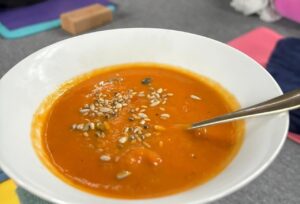 Recipes
Recipes
Courgette and Orange Cake
By Anna Hawrot
Call us on 01452 883232
Hardwicke, Gloucester
62 Westbourne Drive, Hardwicke, Gloucester GL2 4RU
Call us: 01452 883232
Opening Hours
Monday – Thursday: 8am – 7pm
Friday: 8am – 6pm
Saturday: 8am – 12:30pm
Kingsholm, Gloucester
Titan Performance Gym, St Catherine Street, Kingsholm, Gloucester GL1 2BX
Call us: 01452 883232
Meat
As the shooting season comes to a close, game meats like venison, pheasant, and partridge are still available for a few more weeks. After this, sourcing meat from a local butcher is a great option. Although it may be slightly more expensive, the quality of local, sustainably sourced meat is generally far superior, supporting both your health and local producers.
Fruit and Vegetables (Jan–March)
During the early months of the year, we’re fortunate to have a variety of seasonal vegetables available, such as:
These vegetables are not only packed with nutrients but are also likely to be locally grown, which means they haven’t been imported and often have a smaller environmental footprint.
What to Grow in the Garden / What to Plant
If you enjoy growing your own produce, or want to start now is a great time to start planning your garden. You can plant early crops like onions, cabbages, carrots, potatoes and certain varieties of lettuce to set yourself up for the seasons ahead.
One of the easiest ways to incorporate more seasonal food into your diet is through simple, comforting dishes. Here are a few ideas:
Soups
Soup is perfect for this time of year—it’s warming, nourishing, and offers endless variety. A personal favourite of mine is a hearty cauliflower and leek soup, which I always make extra nutritious by adding a slice or two of homemade sourdough bread. The fermentation process in sourdough is great for gut health, and adding a source of protein—either plant-based or from meat. This will balance the meal and keep you fuller for longer.
 Roast Dinners
Roast Dinners
Roast dinners are another excellent way to make the most of seasonal produce. While they require a bit more preparation, the variety of vegetable sides and game meats available at this time of year make them well worth the effort.
Other Ideas
Here are some additional meal ideas to try:
If you’re looking to eat a bit better for the new year, a great starting point is to aim for more variety in your plant intake. Rather than focusing on the common and now outdated goal of ‘5 a day’, new research has shown that eating a variety of 30 different plants over the course of the week should be what we are aiming for. This includes not only fruits and vegetables, the other five plant groups, which include wholegrains, legumes, nuts and seeds and herbs and spices. This simple shift can have a huge positive impact on your health.
Cook from Scratch
Making meals from scratch gives you full control over what goes into your body. If you’re short on time, I recommend focusing on simple, wholesome meals with minimal ingredients. To ensure you’re aware of what you’re consuming, always check the ingredient list. For instance, when buying pre-made bread or pasta, look for basic, recognisable ingredients like water, flour, and yeast—rather than additives or preservatives.
Fermented Foods
Fermented foods are a fantastic addition to any diet, as they introduce beneficial bacteria to your gut. Try adding foods like kimchi, kefir, or sauerkraut to your meals—they’re not only delicious but offer a range of health benefits, including improved digestion and immunity.
 Recipes
Recipes
By Anna Hawrot
 Recipes
Recipes
By Anna Hawrot
 Recipes
Recipes
By Anna Hawrot
 Recipes
Recipes





Spring Sports Therapy Offer
1 hour Sports Therapy session for only £52. Book online or call 01452 883232.
Refer a friend for 10% off
Share the care with our Refer a Friend scheme! When a friend or family member mentions your name and has their first appointment with us, you’ll receive 10% off your next appointment.